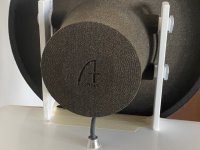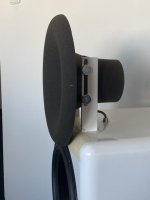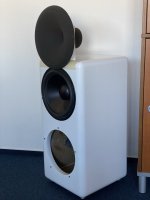The name mabat gave to the throat plug with channels. External Shaping Plug (ESP).Dumb me, what is ESP?
He linked the application note in the name but it might not have been obvious.
http://www.at-horns.eu/release/ath-AP1.pdf
I assumed you knew. Much has been written by JMLC.The diffraction is not only "distributed", it's also lower, IMO.
I've just printed a new one, where the rings have equal area, and played a bit with the exponent on each. Kind of trcky to make them have the values I want without the channels crossing over each other.
I haven't measured it yet, just simulated. The ESP sits on a horn that is about 45cm in diameter and doesn't have a foldback, hence the wavy response.

The newest one I have has the following parameters:
; --------------------------- ESP related code ----------------------------
; Equal Area Rings
; 4 rings: Pos0 = 0.446,0.632,0.774,0.894
; 3 rings: Pos0 = 0.500,0.707,0.866
SP50 = {
Dt = 50
At = 6.3
Ae = 30
L = 80
Pos0 = 0.446,0.632,0.774,0.894
ExpRate = 3,3,3,4,5
Sk = 1
CP1 = 0.2
CP2 = 0.7
;WT = 1
;EndAngle = 1
}
Source.Contours = ::esp SP50 ; source definition
; -------------------------------------------------------------------------
I haven't measured it yet, just simulated. The ESP sits on a horn that is about 45cm in diameter and doesn't have a foldback, hence the wavy response.
The newest one I have has the following parameters:
; --------------------------- ESP related code ----------------------------
; Equal Area Rings
; 4 rings: Pos0 = 0.446,0.632,0.774,0.894
; 3 rings: Pos0 = 0.500,0.707,0.866
SP50 = {
Dt = 50
At = 6.3
Ae = 30
L = 80
Pos0 = 0.446,0.632,0.774,0.894
ExpRate = 3,3,3,4,5
Sk = 1
CP1 = 0.2
CP2 = 0.7
;WT = 1
;EndAngle = 1
}
Source.Contours = ::esp SP50 ; source definition
; -------------------------------------------------------------------------
It has a weird rising spread after 15k that I can't seem to get rid of.Certainly not bad for a 2" throat.
At the same time I'm thinking it's not the worst that can happen to a horn
Yes, it turns out it's not so straightforward to design a perfect conical horn for a spherical source. It still requires some experimentation. I've been quite busy lately so I can't pursue this further myself. In the meantime, I at least implemented variables into the script "language" so I'll be able to perform some pretty complex optimizations, including the ESP parameters. There's still a lot to be achieved, I think.
You GOGO MabatYes, it turns out it's not so straightforward to design a perfect conical horn for a spherical source. It still requires some experimentation. I've been quite busy lately so I can't pursue this further myself. In the meantime, I at least implemented variables into the script "language" so I'll be able to perform some pretty complex optimizations, including the ESP parameters. There's still a lot to be achieved, I think.
I've been considering migrating over to Comsol for that reason. It's faster since it meshes for each frequency, and you can do parameter optimization.
It has a built in CAD, so you can basically design the waveguide (solid and axisymmetic) and let the optimisation tweak the shape within your constraints.
It's quite a bit more difficult to set up, since it's a general physics solver, but it could be an interesting challenge.
I believe @kyleneuron has already gotten the grip of it by now
It is, but occasionally one has a friend in university that has access to itIsn't Comsol extremely expensive?
I think it's not necessary. A strong argument would be the speed but as one iteration takes around a minute in ABEC to solve, I personally don't feel the need. Otherwise everything mentioned is possible with Ath/ABEC as well, if one is willing to create some automated framework around it (still for free). I'm only a bit hesitant to release what I have (using AutoIt and some yet undocumented Ath features), as it's not very user-friendly and I don't have the time for support.
Last edited:
Two examples of speakers using "this horn":
https://www.diyaudio.com/community/threads/hf10ak-12p80nd-custom-wg.360973/https://www.diyaudio.com/community/...-design-the-practical-way.354772/post-6214298
https://www.diyaudio.com/community/threads/hf10ak-12p80nd-custom-wg.360973/https://www.diyaudio.com/community/...-design-the-practical-way.354772/post-6214298
- Home
- Loudspeakers
- Multi-Way
- Acoustic Horn Design – The Easy Way (Ath4)


